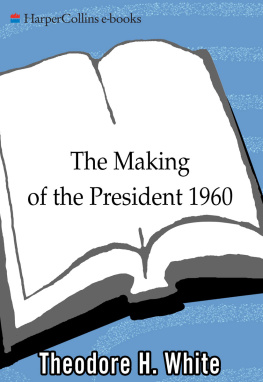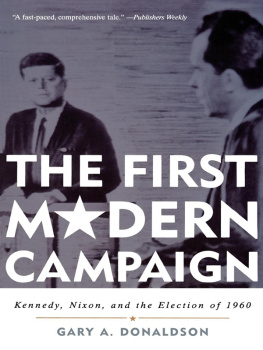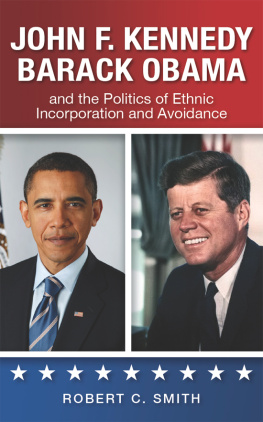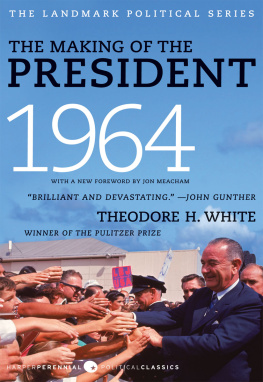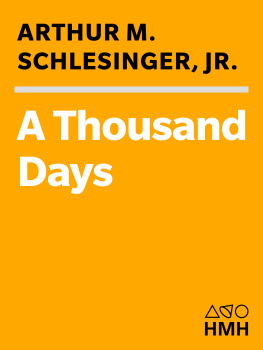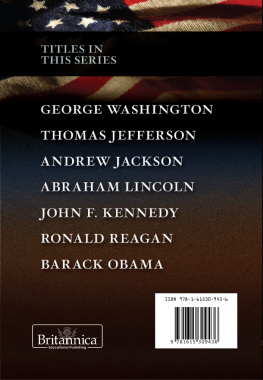Now Secretary of the Navy.
His two favorite anecdotes for the high-school classes were one of General Winfield Scott and another of Madison and Jefferson. General Scott, the candidate would relate, was the first Presidential candidate ever to barnstorm the country looking for votes. But General Scott used the pretext, as he traveled, that he was exploring the country looking for sites for veterans hospitals. Im not here looking for sites for hospitals, Kennedy would say, Im here running for the Presidency and Im here because this is a key primary in a key state and your votes count. Then laughter. The Madison-Jefferson anecdote, when told to children, was much the same. In 1805 Madison and Jefferson had come north from Virginia on what was theoretically a naturalist expedition in which, they claimed, they were looking for butterflies along the Hudson. While in New York, however, they had made the first alliance of Virginians with the Knights of St. Tammany, out of which the present-day Democratic party was to grow into an alliance of Southern and big-city blocs. But Im not here looking for butterflies, Kennedy would say, Im looking for votes. Because this is a key primary in a key state for the key office of the Presidency. The Presidency is important, etc.
Many months later I learned that reports of this speech carried back to Kennedy held that Humphrey had compared him and his organization to Nazi efficiency. This envenomed and embittered Kennedy more than anything else that Humphrey was reported to have said. Since I was there and know this report to be untrue, I am pleased to set the record straight.
The dominant ethnic stocks, listed in no apparent order, were in 1940: Latvian, Italian, Icelander, Croatian-Slovene, old-stock American, Norwegian, Indian, Swedish, Danish, Polish, Finnish, Bohemian, mixture [?], Russian, Irish, Scotch, English, Swiss, German, Belgian, Hollander, Welsh, Lithuanian, French.
See Chapter Eight for a fuller treatment of religion and ethnics in politics.
Whom President Kennedy has now caused to be appointed United States Senator from Massachusetts.
Now Undersecretary of Health, Education and Welfare.
Now Director of the Peace Corps.
Now a White House assistant.
Now Undersecretary of the Navy.
As a matter of political technique, it should be noted that while this full Kennedy first team was employed in West Virginia, a complete second team was simultaneously being deployed in Maryland, whose primary was to follow West Virginias by three days; a third team was being simultaneously fielded in Oregon, whose primary was to follow seven days after that; and a primitive fourth team was being simultaneously fielded in Indiana.
Now United States Ambassador to Guinea.
Now Secretary of Health, Education and Welfare.
I take the following incident from the superb report of Mary McGrory of the Washington Star , who was there at the moment to observe, as I was not.
From West Virginia on, the primaries were all downhill for John F. Kennedy. He had taken New Hampshire overwhelmingly March 8th; taken Wisconsin as we have seen; won Indiana unopposed; swept West Virginia on May 10th. The same day that West Virginia fell to him, the Democratic voters of Nebraska also gave him that state. Maryland gave him its mandate on Friday, May 15th; and Oregon, the last of the contested primaries, gave him a 60 to 40 margin over its native son, Wayne Morse, on May 20th. Political students will note, for whatever significance the fact may bear, that of the seven states in which John F. Kennedy campaigned so brilliantly to earn the Democratic nomination, Richard Nixon was to claim no less than five for his own in the later November election.
C. Douglas Dillon, at that time Undersecretary of State in Eisenhowers cabinet; now Secretary of the Treasury in Kennedys cabinet.
Now Ambassador to Denmark.
Now Chairman of the FCC.
The relapse of the Massachusetts State Democratic Party between 1958 and 1960 to its normal disorderly and vulgar pattern can be ascribed almost completely to the stripping of the state of its best young men to man and operate the Kennedy Presidential operation across the country.
Now Assistant Secretary of State for African Affairs.
Now Secretary of the Interior.
Now Deputy Attorney-General.
Now Undersecretary of State for Economic Affairs.
No cabinet post was later offered this Governor.
The Los Angeles Convention Bureau estimated that the Convention brought, in all, 45,000 visitors to the city.
Several Stevenson leaders assert that the Kennedy walkie-talkies were powerful and sensitive enough to monitor their own more primitive radio communications with the floor.
A partial schedule, covering only the personal morning activities of John F. Kennedy, at the Convention and starting on Monday, July 11th reads like this: On Monday, between 8:30 A.M. and 1:30 P.M. he addressed the caucuses of Nevada, Pennsylvania, Michigan, North Carolina, Arkansas, New York, South Carolina, Florida, Alaska. The afternoon was equally crowded. On Tuesday, between 8:45 and 1:30 he made it to North Carolina, a collective New England breakfast, Wyoming, South Dakota, a nationalities group and California. On Wednesday morning, the day of the balloting, between 9 A.M. and 1:00 P.M. he made it to Indiana, a farm-state caucus, Virginia, Colorado, Hawaii. At this period, it should be added, the activities of the Stevenson and Johnson people were equally frantic.
Now Secretary of Agriculture.
Governor Loveless is now a member of the Renegotiation Board. Governor Docking is now a member of the Board of the Export-Import Bank.
This Robert Frost quotation is also a favorite of John F. Kennedys, much quoted by him during his own campaign.
The packing of the galleries by the Stevensonians, was the result of sharp, well-planned organization. They had been allotted, prior to the Convention, only thirty-five tickets for all their cohorts. They had proceeded thus: first they solicited all members of the 750 Club (a Democratic money-raising device which promised two tickets to each contributor of $1,000) for their unwanted tickets and thus collected 1,000 free tickets; next, they pressed their friends on the host committee of the California Democratic Party to turn over most of their 1,000 tickets to them; finally, learning that the Kennedy organizers expected to draw 2,500 tickets from the regular machinery of the Convention, they had lined their own people up at the special distribution lines for these tickets, pinned on them large KENNEDY buttons, and claimed from the earmarked Kennedy supply an estimated 1500 tickets as their own. The Stevenson people thus, on the night of the Conventions nomination, were in possession of almost 4,000 tickets to pack the galleries; which they did with lusty delight.
Stevenson is now United States Ambassador to the United Nations.
The final tally of the first ballot at the Democratic National Convention of 1960 was: Kennedy, 806; Johnson, 409; Symington, 86; Stevenson, 79; all others put together, 140.
Now Special Assistant to the President of the United States.
Now Secretary of Labor.
The documents, all of them study papers hard in proposal, specific in fact, covered: American economic growth, civil rights, foreign affairs, national defense, government reorganization, health care for the aged, disarmament and arms control, education, Latin-American unity and a general summation prepared for the Republican Party Platform.
The full report of Mr. Percys year-long labors is available in a booklet entitled Decisions for a Better America , published by Doubleday & Company, New York.
See Appendix B for full text.
I rely for this version of the Vice-Presidential selection on the excellent and exclusive reporting of Carleton Kent, in the Chicago Sun-Times , reporting acknowledged by those who were present to be authentic.
Next page
